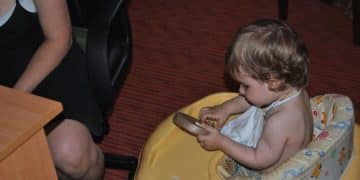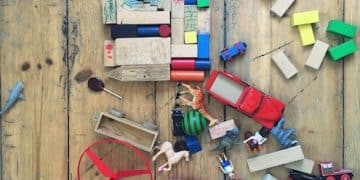Potty Training in 7 Days: A Step-by-Step Guide Without the Struggles
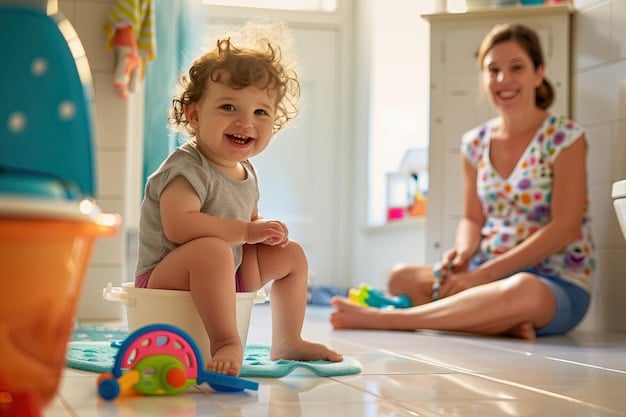
Potty training can be a stress-free experience for both you and your child with the right approach; this step-by-step guide provides a 7-day plan to achieve potty training success without power struggles, focusing on patience, positive reinforcement, and creating a comfortable environment.
Ready to say goodbye to diapers and hello to potty independence? This guide, Potty Training Without the Power Struggles: A Step-by-Step Guide for Success in 7 Days, will show you how to make potty training a positive and successful experience for everyone involved. Let’s dive in and make potty training a breeze!
Understanding Readiness for Potty Training
Before embarking on the potty training journey, it’s crucial to assess whether your child is truly ready. Starting too early can lead to frustration and setbacks, while waiting too long might delay their independence. Look for a combination of physical, cognitive, and emotional signs to determine if your little one is prepared to take this big step.
Physical Signs of Readiness
These signs indicate that your child has the necessary physical control to begin potty training.
- Staying dry for longer periods: Can your child keep their diaper dry for at least two hours during the day?
- Predictable bowel movements: Do they have bowel movements around the same time each day?
- Control of bladder and bowel muscles: Can they pull their pants up and down independently?
Cognitive and Emotional Signs of Readiness
These signs suggest that your child understands the concept of potty training and is motivated to participate.
- Expressing awareness of bodily functions: Do they tell you when they’re peeing or pooping in their diaper?
- Showing interest in using the toilet: Do they watch you use the toilet or ask questions about it?
- Following simple instructions: Can they understand and follow basic directions?
- Desire for independence: Do they show a general eagerness to do things on their own?
Remember, every child develops at their own pace. If your child doesn’t exhibit all of these signs, it doesn’t mean they’ll never be ready. It simply indicates that it might be beneficial to wait a few weeks or months before trying again. Pushing them before they’re ready can create unnecessary stress and resistance.
Assessing your child’s readiness is the first and most important step in ensuring a smooth and positive potty training experience. By carefully observing their physical, cognitive, and emotional cues, you can set them up for success from the very beginning.
Preparing for the 7-Day Potty Training Plan
Once you’ve determined your child is ready, it’s time to prepare for the 7-day potty training plan. This involves gathering the necessary supplies, setting up the environment, and mentally preparing yourself for the journey ahead. A little preparation can go a long way in ensuring a successful and stress-free experience.
Gathering Essential Potty Training Supplies
Having the right tools at your disposal will make the process much easier and more efficient.
- Potty chair or toilet seat adapter: Choose whichever option your child seems most comfortable with.
- Training underwear: Purchase several pairs, as accidents are bound to happen.
- Loose-fitting clothing: Easy-to-remove clothing will help your child get to the potty quickly.
- Rewards: Stickers, small toys, or even a special activity can serve as positive reinforcement.
- Cleaning supplies: Be prepared for accidents with wipes, disinfectant, and a change of clothes.
Creating a Potty-Friendly Environment
Make the bathroom a welcoming and accessible space for your child.
- Place the potty chair in a convenient location: Somewhere easily accessible and comfortable for your child.
- Make the bathroom inviting: Add colorful decorations, books, or toys to make it a positive space.
- Ensure easy access to the toilet: If using a toilet seat adapter, make sure it’s securely in place.
Setting Expectations and Staying Positive
Your attitude and approach will significantly influence your child’s experience.
- Be patient and understanding: Accidents are a normal part of the process.
- Offer encouragement and praise: Celebrate every success, no matter how small.
- Avoid scolding or punishment: This can create negative associations with potty training.
- Stay consistent: Stick to the plan and avoid sending mixed messages.
Preparing for potty training isn’t just about gathering supplies; it’s about creating a supportive and encouraging environment that fosters your child’s confidence and independence. By setting realistic expectations, staying positive, and providing consistent support, you can help your child navigate this significant milestone with ease.
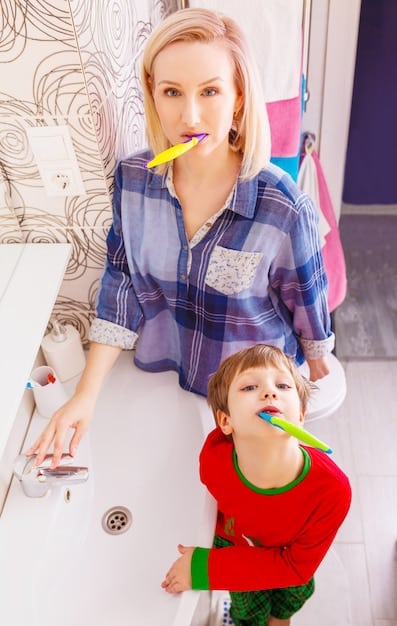
Day 1 & 2: Introduction and Intensive Training
The first two days of the 7-day potty training plan are dedicated to intensive training, focusing on introducing your child to the potty and establishing a regular routine. This involves frequent trips to the potty, lots of encouragement, and a supportive, patient approach. Remember, consistency is key during these initial days.
Frequent Potty Breaks
Start by taking your child to the potty every 20-30 minutes.
Set a timer and remind them gently that it’s time to try. Even if they don’t need to go, the consistent routine will help them become more aware of their body’s signals. Make it a fun activity by reading a book or singing a song while they sit on the potty.
Positive Reinforcement and Rewards
Celebrate every success, no matter how small.
Offer praise, stickers, or a small toy when they successfully use the potty. Avoid creating too much excitement, as this can pressure them. Simply acknowledge their accomplishment with a smile and a verbal reward, such as “Great job using the potty!”
Dealing with Accidents
Accidents are inevitable during potty training. It’s important to respond calmly and without judgment.
Avoid scolding or punishing your child. Instead, simply clean up the mess and remind them that the potty is where pee and poop belong. You can say something like, “Oops, that’s okay. Let’s try to use the potty next time.”
Days 1 and 2 are the most intensive part of the potty training process. By establishing a consistent routine, offering positive reinforcement, and responding calmly to accidents, you can lay a strong foundation for success. Remember to stay patient, supportive, and focus on making the experience positive for your child.
Day 3 & 4: Reinforcing the Potty Routine
As you move into days 3 and 4 of the 7-day potty training plan, the focus shifts to reinforcing the established routine and encouraging your child to recognize their own body’s signals. While the intensive training continues, you can start to give them more responsibility and independence.
Encouraging Independence
Empower your child to take ownership of the potty training process.
- Let them choose their underwear: This gives them a sense of control and excitement.
- Encourage them to pull down their pants and sit on the potty independently: Offer assistance only when needed.
- Ask them if they need to go: Gently prompt them to listen to their body’s signals.
Extending Intervals Between Potty Breaks
Gradually increase the time between scheduled potty breaks.
- Monitor their behavior: Look for signs that they might need to go, such as fidgeting or squatting.
- Offer reminders: Gently remind them to use the potty before leaving the house or engaging in activities.
Addressing Resistance
It’s not uncommon for children to resist potty training at times. Understanding the reasons behind their resistance and responding with empathy is crucial.
If they refuse to sit on the potty, don’t force them. Simply say, “Okay, we can try again in a little while.” Try to identify the underlying cause of their resistance. Are they afraid of the toilet? Are they feeling pressured? Addressing these concerns can help alleviate their anxiety.
Days 3 and 4 are about reinforcing the potty training routine and fostering your child’s independence. By encouraging them to recognize their body’s signals, extending intervals between potty breaks, and addressing any resistance with empathy, you can help them solidify their progress and gain confidence in their abilities.
Day 5 & 6: Outings and Naps
Days 5 and 6 present new challenges as you start to venture outside the familiar environment of your home and navigate naps and nighttime. These situations require careful planning and adaptation of the potty training strategies you’ve been using so far.
Potty Training on the Go
Plan ahead for outings to minimize accidents and maintain consistency.
- Pack a portable potty seat: This allows your child to use public restrooms with confidence.
- Bring extra changes of clothes: Accidents are more likely to happen in unfamiliar environments.
- Plan potty breaks: Identify restrooms along your route and stop frequently.
- Use pull-ups during longer trips: This can provide reassurance and prevent accidents in situations where a restroom isn’t readily available.
Naps and Nighttime Potty Training
Naps and nighttime potty training can be approached separately, as they require different strategies.
Before naps, encourage your child to use the potty. Limit fluids before naptime to reduce the likelihood of accidents. Use a waterproof mattress protector to protect the bed. If your child wakes up dry for several days in a row, you can try transitioning to underwear during naps.
Managing Setbacks
Setbacks are a normal part of the potty training process, especially when introducing new environments and situations.
Don’t get discouraged if accidents happen during outings or naps. Simply clean them up and reassure your child that it’s okay. Remind them of the potty routine and encourage them to try again next time. Focus on the progress they’ve made and celebrate their successes to maintain their confidence.
Days 5 and 6 are about extending potty training to new situations and adapting your strategies to meet the challenges of outings and naps. By planning ahead, remaining patient, and addressing setbacks with understanding, you can help your child maintain their progress and build confidence in their abilities.
Day 7: Celebrating Success and Maintaining Consistency
Congratulations, you’ve reached day 7 of the potty training plan! This day is about celebrating your child’s accomplishments and solidifying the progress they’ve made. While the intensive training phase is over, it’s crucial to maintain consistency and continue to provide support and encouragement.
Celebrating Milestones
Acknowledge and celebrate your child’s success in a meaningful way.
Plan a special activity or give them a small reward to commemorate their achievement. This could be a trip to the park, a new book, or a special sticker. Make sure they understand that they’ve accomplished a significant milestone and that you’re proud of them.
Maintaining the Potty Routine
Continue to follow the established potty training routine, even after day 7.
Remind them to use the potty regularly, especially before leaving the house or engaging in activities. Encourage them to listen to their body’s signals and take initiative. Be prepared for occasional accidents, especially during times of stress or change. Simply respond calmly and remind them of the potty routine.
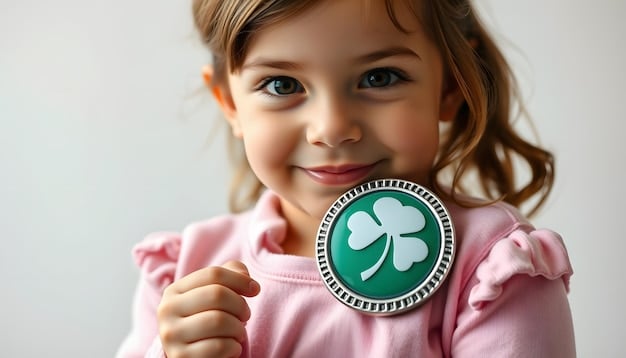
Long-Term Potty Training Success
Potty training is an ongoing process, and it may take several months for your child to become fully independent and confident.
Continue to provide support and encouragement, and celebrate their successes along the way. You can gradually reduce the frequency of reminders and allow them to take more responsibility for their potty habits. Most importantly, remember to be patient and understanding, and to create a positive and supportive environment that fosters their independence.
Day 7 is a celebration of your child’s accomplishments and a commitment to maintaining consistency and providing ongoing support. By celebrating their successes, reinforcing the potty routine, and remaining patient and understanding, you can help your child achieve long-term potty training success and build their confidence in their abilities.
Addressing Common Potty Training Challenges
Even with the best preparation and a well-structured plan, you might encounter some common challenges during the potty training process. Understanding these challenges and having strategies to address them can help you navigate setbacks and keep your child on track.
Potty Training Regression
Regression, where a child who was previously potty trained starts having accidents again, is a common occurrence.
Identify the underlying cause of the regression. Is it due to stress, illness, or a change in routine? Address the root cause and provide extra support and encouragement. Revisit the basic potty training principles and reinforce the routine. Avoid scolding or punishing your child, as this can worsen the problem.
Fear of the Toilet
Some children develop a fear of the toilet, which can make potty training difficult.
Try to understand the source of their fear. Are they afraid of the flushing sound? Are they worried about falling in? Make the toilet less intimidating by using a toilet seat adapter. Let them flush the toilet themselves after they’re done. Read books or watch videos about potty training to help them understand the process.
Constipation
Constipation can be a significant obstacle to potty training.
Encourage your child to drink plenty of fluids and eat a diet rich in fiber. Talk to your pediatrician about safe and effective ways to relieve constipation. Make sure they’re comfortable sitting on the potty and encourage them to relax. Address any underlying anxieties or fears related to bowel movements.
Addressing common potty training challenges requires patience, understanding, and a willingness to adapt your strategies. By identifying the underlying causes of setbacks, addressing fears, and managing constipation, you can help your child overcome these obstacles and achieve potty training success.
| Key Point | Brief Description |
|---|---|
| 🚽 Readiness Assessment | Ensure your child shows physical and emotional signs of readiness before starting. |
| 🗓️ 7-Day Plan | Follow a structured 7-day approach, adjusting as needed for your child. |
| 🎉 Positive Reinforcement | Use praise and small rewards to celebrate successes without pressure. |
| 💪 Consistency is Key | Maintain a consistent routine and respond calmly to accidents. |
Frequently Asked Questions
▼
Most children are ready between 18 months and 3 years old, but it varies. Look for signs of readiness rather than focusing solely on age.
▼
Stay calm and avoid scolding. Clean up the mess and remind your child that pee and poop go in the potty. Encourage them to try again next time.
▼
Don’t force them. Take a break and try again later. Try to understand why they’re refusing; are they scared or anxious? Address their concerns gently.
▼
While this guide focuses on 7 days, full potty training can take weeks or months. Stay consistent and patient; every child learns at their own pace.
▼
Pull-ups can be helpful for outings or naps, but using them full-time can confuse your child. Use them strategically and encourage underwear use as much as possible.
Conclusion
Potty training without the power struggles is achievable with the right approach, patience, and a consistent plan. By understanding your child’s readiness, creating a supportive environment, and celebrating their successes, you can guide them towards potty independence in a positive and stress-free way. Remember, every child is unique, so adapt the 7-day plan to fit their individual needs and celebrate every small victory along the way.

